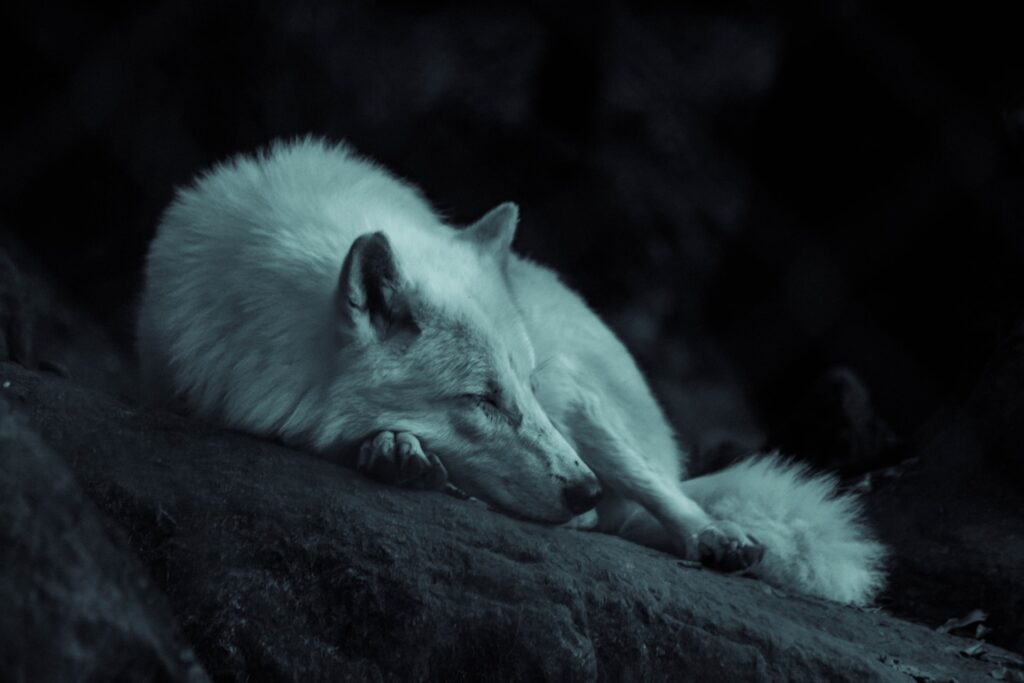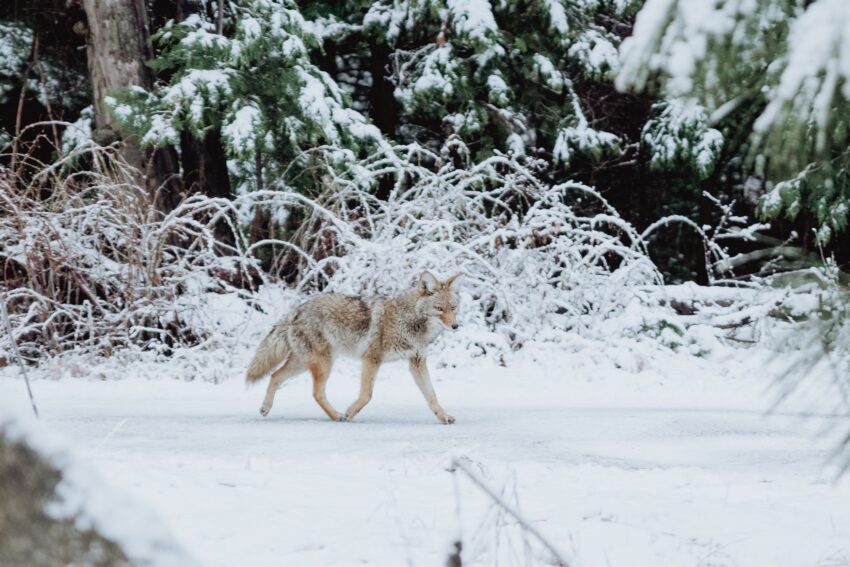Finding wolf footprints may be an interesting experience because wolves are elusive and seldom seen. The charts and information below show some of the differences between wolf tracks and those of their near cousins, coyotes and domestic dogs. Each species’ front and rear feet have four symmetrical toes, with the front track being slightly longer and wider than the hind. Claw marks are common, and the front of a wolf’s foot pad has a single lobe. Because the distinctions are not always obvious, search for a combination of features before reaching a judgment.
Gray wolves are roughly twice as large as coyotes. They may grow to be up to 6 feet long, including the tail, and 30 inches tall at the shoulder. Female wolves weigh between 70 and 80 pounds, while males weigh between 95 and 100 pounds.
Wolves have broader, blockier muzzles than coyotes, as well as shorter, more rounded ears and shorter, bushier tails. Wolves come in a variety of colors, including black, white, gray, and brown.
Wolf footprints are approximately 5 inches long by 4 inches broad, with four symmetrical toes and visible claws, as well as a single lobe on the front of the foot pad. Coyote footprints are comparable but half the size, and even the largest domestic dog breeds often have smaller traces. Wolves’ pathways are generally straight, energy efficient, or purposeful, but dogs’ paths are often meandering.
Identification of wolf tracks
It’s not always simple to spot a wolf trace. Because the wolf is making a resurgence in several parts of Europe, I’ll explain how to identify a wolf trace in this section. First and foremost, I want to emphasize that wolves avoid humans at all costs. Wolf attacks in Europe are a source of concern in modern Europe.
With the foregoing information about wolf size, it’s already a little simpler to envision a wolf trail. Wolf footprints resemble dog tracks, yet there are several dog breeds. Wolf tracks are often bigger. Between 8 and 12cm in length.
There are a few more characteristics to look for when distinguishing between wolf and dog footprints. First and foremost, they each have four toes and a heelpath. Cats have retractable claws, whereas members of the canid or dog family have claws that are virtually always visible in the tracks.
The majority of my photos are from snow tracking in Slovakia, but I also included some sand traces.
Wolf Tracks
Wolf prints (and dog prints) are also more symmetrical than cat tracks. The general form of the track is droplet-like. In wolf footprints, the front toes are more forward and elliptic. The other two toes are more triangular in form. In wolves, the two front toes are frequently driven deeper into the substrate than the remainder of the print. Wolves prefer to run on their toe tips. This is especially noticeable in soft soils.
In general, the second row of toes in dogs overlaps more with the front toes, resulting in less negative space in dog prints.
There is more ‘negative space’ in the center of the wolf track because the two front toes are closer together. You may draw an X-shape via the tracks, but dogs are supposed to produce an H-shape. Toes 3 and 4 (front toes) have claws that point straight forward or inwards.
There is a difference between the front and back foot, which is more noticeable in wolves. The back heelpath is triangular in shape and thinner. The heelpath in the front foot is more ‘heart-shaped.’
The front tracks, like those of other carnivores, are broader and wider, with a more roundish appearance. The rear feet are more oval and designed for speed and power, but the front feet are designed for stability since they must bear greater weight.
When hunting for tracks in the field, it’s usually a good idea to keep an eye on the surroundings and the discoveries. When the substrate is good, it’s definitely worth taking a step back and inspecting the track pattern. It has the potential to expose certain behavioral inner workings. Wolves use less energy than other animals. They run in more straight lines because they have a goal. Dogs, on the other hand, prefer to prowl about more. Dogs are less concerned about energy since they know they will be fed in the evening. In heavy snow, wolves would even follow in each other’s footprints to conserve energy.
If you witness one track change into a couple of tacks and then back into one track, this might be another indication.
It’s a good idea to keep an eye out for tracks on sandy trails, and to double-check road and path intersections.
Claws and Toes
Large dogs’ toes are frequently splayed, with all four toes spreading outward. Spread is less prevalent in wolves, and if it occurs, it generally affects only the outer two toes. Wolves’ front claws are longer and more visible in tracks than their back claws, but both can be seen. The presence of claws in dog footprints varies.
Scats of the Wolf
Wolves excrete scats, or droppings, that are often made up of hair, bone pieces, and other traces of their carnivorous diet. Coyote scats, which are normally smaller than wolf scats, typically include tiny animal remnants, berries, or insects, however there may be some overlap in contents and appearance. Domestic dog scats have a more uniform texture and shape, with no visible hair or bone fragments. To avoid parasites, avoid touching scats.
Other Wolf Tracks
Did you know that wolves have extremely strong jaws that can crush bones? Crushed bones are one of the characteristics of a suspected wolf death scene if you’ve ever discovered one. Other symptoms exist, but they are too many for this basic blog entry.
Wolves against Coyotes
The traces of adult wolves are bigger and more robust than those of adult coyotes. Young wolves’ feet develop fast, and by the time they are three months old (about July), their traces are bigger than most coyote tracks. Because wolves are significantly heavier than coyotes, their footprints will have greater spread in their toes, especially on the front track, than coyotes’. Claws on the front foot of wolves are longer than those on the rear, yet both register clearly.

Wolves In comparison to domestic dogs
Wolf footprints are bigger than those of all but the largest kinds of domestic dogs, who are wolves’ genetic descendants. While many dog footprints can be recognized from wolf tracks, certain domestic dogs have traces that are quite similar to wolf tracks, rendering them unrecognizable in particular situations. Use the instructions below to help you identify tracks. Keep in mind, however, that traces alone cannot reliably distinguish domestic dogs from wild canids.
How can you improve your chances of sighting a wolf?
To conclude this essay, I will discuss ways to enhance your chances of sighting a wolf. Wolves, as previously said, move about a lot. As a result, you might improve your odds by locating an advantage position that views a greater region. It is preferable if this place is not disturbed.
Learning about wolf trails and indications is another approach to improve your odds. Although, in the wild, it might be difficult to discern between wolves and big dogs. However, combining all of the available indications might result in a successful sighting.

